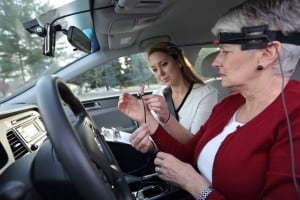
New AAA Foundation for Traffic Research shows that hands-free technologies can mentally distract drivers even if their eyes are on the road and their hands are on the wheel.
The research found that practice with voice-recognition systems doesn’t eliminate distraction. The studies also showed older drivers – those most likely to buy autos with infotainment systems – are much more distracted than younger drivers when giving voice commands.
 In the in-car information system study, the researchers did an initial test on the subjects, then let them take the cars home for five days to practice using the systems. Then they returned for reassessment of the mental workload from using the systems. The best performing system was the Chevy Equinox with a cognitive distraction rating of 2.4, while the worst performing system was the Mazda 6 with a cognitive distraction rating of 4.6.
In the in-car information system study, the researchers did an initial test on the subjects, then let them take the cars home for five days to practice using the systems. Then they returned for reassessment of the mental workload from using the systems. The best performing system was the Chevy Equinox with a cognitive distraction rating of 2.4, while the worst performing system was the Mazda 6 with a cognitive distraction rating of 4.6.
A study of smartphone systems found all three major smartphone personal assistants either highly or very highly distracting. Two scores were given to each voice-based system: A lower number for using voice commands only to make calls or change music when driving – the same tasks done with the in-car systems – and a higher number that also included using smartphones to send texts by voice commands. Google Now rated highly distracting (3.0, 3.3), as did Apple Siri (3.4, 3.7), while Microsoft Cortana rated highly to very highly distracting (3.8, 4.1).
The vast majority of people tested ended up being frustrated by the complexity and error-prone nature of the systems, noted Joel Cooper who also observed Many of these systems have been put into cars with a voice-recognition system to control entertainment: Facebook, Twitter, Instagram, Snapchat, Facetime, etc. We are now trying to entertain the driver rather than keep the driver’s attention on the road.”
Researchers found that potentially unsafe levels of mental distraction can last for as long as 27 seconds after completing a distracting task in the worst-performing systems studied. At the 25 MPH speed limit in the study, drivers traveled the length of nearly three football fields during this time. When using the least distracting systems, drivers remained impaired for more than 15 seconds after completing a task.
The researchers discovered the residual effects of mental distraction while comparing new hands-free technologies in ten 2015 vehicles and three types of smartphones. The analysis found that all systems studied increased mental distraction to potentially unsafe levels. The systems that performed best generally had fewer errors, required less time on task and were relatively easy to use.
The researchers rated mental distraction on a five-point scale. Category one represents a mild level of distraction and category five represents the maximum. AAA considers a mental distraction rating of two and higher to be potentially dangerous while driving.
“The results indicate that motorists could miss stop signs, pedestrians and other vehicles while the mind is readjusting to the task of driving,” said Peter Kissinger, President and CEO of the AAA Foundation for Traffic Safety.
“The massive increase in voice-activated technologies in cars and phones represents a growing safety problem for drivers,” said Marshall Doney, AAA’s President and CEO, “We are concerned that these new systems may invite driver distraction, even as overwhelming scientific evidence concludes that hands-free is not risk free.”
Previous AAA Foundation research established that a category 1 mental distraction is about the same as listening to the radio or an audio book. A category 2 distraction is about the same as talking on the phone, while category 3 is equivalent to sending voice-activated texts on a perfect, error-free system. Category 4 is similar to updating social media while driving, while category 5 corresponds to a highly-challenging, scientific test designed to overload a driver’s attention.
Over the last two weeks, AAA has used the findings to continue collaborative work with policymakers, safety advocates and manufacturers to improve the safety of future technology.
“Developers should reduce mental distractions by designing systems that are no more demanding than listening to the radio or an audiobook,” continued Doney. “Given that the impairing effects of distraction may last much longer than people realize, AAA advises consumers to use caution when interacting with these technologies while behind the wheel.”
Dr. David Strayer and Dr. Joel Cooper of the University of Utah conducted the research. A total of 257 drivers ages 21-70 participated in the study of 2015 model-year vehicles, while 65 additional drivers ages 21-68 tested the three phone systems.
The video is very humorous as long as you are not the one trying to complete the voice command.
Read full report.
https://vimeo.com/aaapublicaffairs/review/141697388/791daa0c75